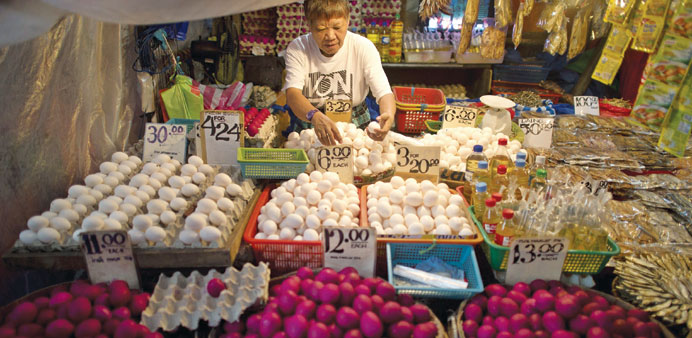A vendor arranges eggs for sale at a market in Manila. Philippine’s GDP slowed to a seasonally adjusted 0.3% in the January-March quarter, the statistics agency said.
Reuters/Manila
Philippine economic growth unexpectedly slowed to a six-year low in the first quarter, but the central bank said it would not ease policy as consumer and public spending were set to pick up.
Still, economists doubted Manila’s 7-8% growth target for the full year could be met without additional interest rate cuts or a sharp increase in fiscal spending, which has been slowed by a corruption scandal and bureaucracy.
“It is very disappointing. This may trigger speculation that the Bangko Sentral ng Pilipinas (BSP) will consider easing policy rates in the June policy meeting, more so that inflation (data) for May and June are expected to be some of the lowest this year,” said Emilio Neri, economist at the Bank of the Philippine Islands.
He added that growth in the second quarter was unlikely to be strong as the worst of the El Nino dry weather phenomenon affects agricultural production.
First quarter GDP slowed to a seasonally adjusted 0.3% in the January-March quarter from 2.5% in the fourth quarter, the weakest in six years, the statistics agency said. A Reuters poll had forecast 1.4% growth.
Southeast Asia’s fifth-largest economy has so far bucked the global trend of policy easing due to solid economic growth. The Philippines remains one of the fastest-growing in the region, and its improved fiscal position and governance has also led to ratings upgrades, making it a standout with investors.
The government, however, has failed to roll out planned state spending but government officials say spending will pick up ahead of next year’s presidential polls.
From a year earlier, the economy grew 5.2% in the first quarter, below the 6.6% predicted by economists and the slowest in more than three years.
Government final consumption spending rose 4.8%, down from 9.4% in the fourth quarter. But private spending remained strong, with household consumption climbing 5.4%, higher than 5% in the fourth quarter.
Growth in manufacturing was 5.9%, lower than the previous quarter’s 7.7%, as exports grew only 1% against 12.8% in the previous quarter.
The weakness in exports was expected with the global economy hitting a soft patch early in the year, said Daniel Martin, senior Asia economist at Capital Economics, adding exports should rebound.
Despite the lacklustre performance, Economic Planning Secretary Arsenio Balisacan told a news conference the government was not abandoning this year’s 7-8% growth goal as rice imports would also offset the impact of El Nino.
The peso eased against the US dollar after the data while the main stock index fell 1.6%. The central bank said liquidity in the economy was sufficient and domestic credit conditions support growth.
“I don’t see compelling need to provide additional monetary stimulus,” said central bank Deputy Governor Diwa Guinigundo.

